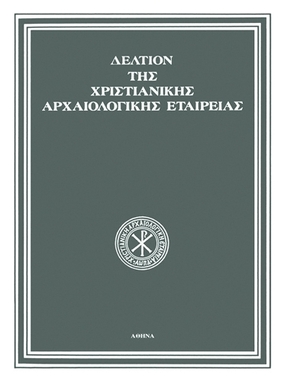Άγιος Νικόλαος στο νεκροταφείο Καλάμου Αττικής : Νέα στοιχεία
Part of : Δελτίον της Χριστιανικής Αρχαιολογικής Εταιρείας ; Vol.29, 1983, pages 227-248
Issue:
Pages:
227-248
Parallel Title:
Fresh Data from the Cemeterial Church of St. Nicholas at Kalamos, Attica
Section Title:
Articles
Abstract:
The church of St. Nicholas at Kalamos, Attica, is an interesting monument because of its unusual architectural type and the fine frescoes decorating its narthex, which are dated in the late 13th century. It is a threenaved church with a transverse vault and belongs to the type Γ2 of Professor A. K. Orlandos classification.Although still incomplete, restoration works carried out recently haverevealed some interesting information on the history of the monument. Observation and study of certain morphological and constructional details, afterremoval of the outer layers of plaster, lend further support to a dating ofthe church in the 13th century, as originally proposed by Professor Bouras.Besides, operations for the maintenance of the roof and foundations of thismonument have disclosed the existence, on the same site, of an earlier churchof larger dimensions, decorated with wall paintings.A number of fresco fragments, reused as rubble in the vault of thebarrel-vaulted SW section of the cruciform church of St. Nicholas, havesupplied evidence relating to the fresco decoration of the earlier church.Dating of the fragments —mainly those showing the faces of angels andother holy figures— has been based on the few stylistic observations allowedby the nature of the material available, while the narthex frescoes of thelate 13th century have provided a terminus ante quern for the dating of thesefragments.Careful observation of the modelling of the faces and other characteristic features reveals certain stylistic similarities between these fragmentsand a number of frescoes found in Attica and dated in the first half of the13th century. These works, regarded as of a more or less provincial style,include a group of frescoes in the church of St. Peter at Kalyvia Kouvara, inthe chapel at Spilia Pendelis, and in the church of the Panagia tis Merendasat Markopoulo, the latter being of a more marked provincial character.In the faces pictured on the fresco fragments from Kalamos, the linearrendering is combined with a substantially free drawing and enhances theeffect of expressiveness. Moreover, the painter's crisp modelling and hisattempt to add greater depth, as well as a sence of the third dimension, makesthese frescoes particularly lively and diversifies them to a certain degreefrom the stylistic trend to which they have been classified.Quite apart from their artistic merit, these fresco fragments, which are dated in the early decades of the 13th century, provide further evidence ofthe brisk artistic activity manifested in Attica during the period of the Frankishoccupation.The continuation of works on this monument, with the cleaning ofthe frescoes in the narthex and nave, is necessary in order to form a morecomplete picture of the church and its history, in the light of the fresh evidence yielded by the latest archaeological works.
Subject:
Subject (LC):




